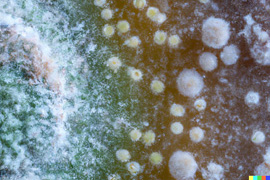 Overview of mycotoxin-producing microorganisms – Mycotoxins are secondary metabolites produced by various types of mold or bacteria. These toxins can cause a range of health problems, including immune system weakening, neurological disorders, allergic reactions, and even cancer. For building biologists, particularly important are the types of mold that produce mycotoxins and grow indoors. The most common types include Aspergillus, Penicillium, Stachybotrys, and Cladosporium.
Overview of mycotoxin-producing microorganisms – Mycotoxins are secondary metabolites produced by various types of mold or bacteria. These toxins can cause a range of health problems, including immune system weakening, neurological disorders, allergic reactions, and even cancer. For building biologists, particularly important are the types of mold that produce mycotoxins and grow indoors. The most common types include Aspergillus, Penicillium, Stachybotrys, and Cladosporium.
Aspergillus
Aspergillus species are widespread in indoor environments and can produce a variety of mycotoxins. A. flavus and A. parasiticus are known for producing aflatoxins, which are classified as highly carcinogenic. A. fumigatus produces gliotoxin, which has immune-modulating properties. Aspergillus versicolor is another species found indoors that produces sterigmatocystin, a toxin considered a precursor to aflatoxins and poses similar health risks.
Penicillium
Penicillium species are also commonly found indoors. P. chrysogenum, one of the most common indoor fungi, is known for producing penicillin, but also mycotoxins such as Roquefortin C and Meleagrin. Penicillium brevicompactum produces mycophenolic acid, a toxin with immune-modulating properties.
Stachybotrys
Stachybotrys chartarum, also known as “Black Mold”, is another indoor fungus that can produce mycotoxins. This fungus produces a group of toxins called trichothecenes, especially stachybotrys. These toxins can cause skin irritations, respiratory problems, and immune system weakening.
Cladosporium
While Cladosporium species are generally considered less toxic, they can still produce mycotoxins like cladosporin. These toxins are less well characterized, but there is evidence that they can cause allergic reactions and respiratory problems.
Other Genera
Other genera like Trichoderma, Fusarium, and Alternaria can also be found indoors, albeit less frequently. Trichoderma species can produce peptaibols, Fusarium species zearalenone and fumonisins, and Alternaria species alternariol and tenuazonic acid.
Bacteria as Mycotoxin Producers
While mycotoxins are primarily produced by mold, there are bacterial species that can produce toxic metabolites indoors, which have effects similar to mycotoxins. Actinomycetes are a group of gram-positive bacteria that resemble fungi in morphology. Some actinomycetes can produce compounds that act as toxins. For example, Streptomyces can produce various secondary metabolites that are toxic. Although these bacteria can be found indoors, especially in moist environments, their role in toxin formation in such settings is not well characterized. These bacteria can, but do not necessarily have to, produce toxins. Various factors, such as living conditions, nutrient availability, or specific strains, influence whether and to what extent toxins are formed.
Health Impacts and Risk Assessment
The health risks posed by mycotoxins in indoor settings range from allergic reactions and respiratory diseases to serious immunological and neurological disorders. For example, aflatoxins are classified as potential carcinogens. The risk assessment for mycotoxins indoors is complex and requires a multidisciplinary approach encompassing toxicology, microbiology, epidemiology, and building engineering.
Summary
While mycotoxins are primarily produced by molds, bacterial species can produce toxic metabolites indoors. It is therefore important to identify both mold and potentially toxic bacteria indoors to minimize health risks. If there is a suspicion of the presence of such organisms, an indoor air measurement for MVOC (Microbial-Volatile-Organic-Compounds) should be carried out, and if necessary, remediation measures should be undertaken.
